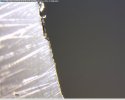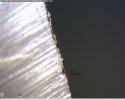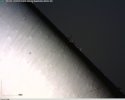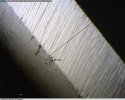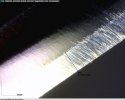- Joined
- Sep 29, 2010
- Messages
- 108
I speed read through this thread and didnt find an answer to this. Is it ok to remove a burr by making a microbevel ?
Yes, but (there's always a "but" isn't there
Jack
I speed read through this thread and didnt find an answer to this. Is it ok to remove a burr by making a microbevel ?
Well put, Jackknifeh
Burrs and pressure are closely related, then add in the extremely small surface area of the microbevel and that pesky burr is easily produced, harder to remove, and really small. Your also limited in the number of passes you can make before the micro becomes not so micro and starts to affect performance.
What I really wanted to comment on though was the angle combo's, when I experimented with micros that +10 degree increase on the microbevel always seemed like the magic number. Your 26-36 is very similar to the angles I used and found offered the greatest strength and cutting ability. How are you finishing the back bevel in comparison to the micro?

Remember, always work the TA to the angle you
want and set the CA about 5 degrees greater
(improves durability) than TA. The steeper the
angles the easier it is for the edge to be damaged.
Ultra fine cutting may require a thinner (steep) TA (10
to 15 degrees). Hollow ground blades seem fragile,
but they are easy to sharpen. A general purpose TA
for meat would be 15 to 20 degrees. Tough use
knives need a TA of 25 to 30 degrees. I like my ax set with a thick TA (35 to 40 degrees). The TA on my ax is very
short (the opposite of hollow ground). I think (not sure, just think) this improves the durability of the cutting edge It
needs to be tough, I cut a lot of bone with my ax. These thicker angles do not affect the sharpness. My ax will
shave
This is probably true, and possibly measurable.It increases the force needed to make a cut.
Remember, always work the TA to the angle you
want and set the CA about 5 degrees greater
(improves durability) than TA. The steeper the
angles the easier it is for the edge to be damaged.
Ultra fine cutting may require a thinner (steep) T
to 15 degrees). Hollow ground blades seem fragile,
but they are easy to sharpen. A general purpose TA
for meat would be 15 to 20 degrees. Tough use
knives need a TA of 25 to 30 degrees. I like my ax set with a thick TA (35 to 40 degrees). The TA on my ax is very
short (the opposite of hollow ground). I think (not sure, just think) this improves the durability of the cutting edge … It
needs to be tough, I cut a lot of bone with my ax. These thicker angles do not affect the sharpness. My ax will
shave …
Very nice way of putting it....it's just I don't want to say microbevels are 100% benefit and 0% drawback. They're 85-99.997% benefit.
Very nice way of putting it....
and I admire
your level of precision
--
Vincent
http://picasaweb.com/UnknownVincent?showall=true
http://UnknownVincent.Shutterfly.com
http://UnknownVT.Shutterfly.com
http://UnknownVT.multiply.com/photos
Alright, I have skimmed this thread and found some good info. I would like to tell you guys my setup and see if it is sufficient to do micro bevels. I only use a GATCO guided rod system with diamond coarse, medium, fine, and then I bought a GATCO ceramic ultra finishing hone to finish it. I have experimented with stropping but have not mastered it and the ceramic seems to get knifes pretty sharp, phone book slicing sharp. I just tried a micro bevel on a cheap knife, 8Cr13MoV steel. I started by putting a 30 degree inclusive on it and spent very little time with the ceramic. This was starting with the coarse because it was still the factory edge. Then again with all diamonds and ceramic I used the 19 degree hole so 38 total. Should I be able to see the micro bevel with the naked eye? When I put the diamond hone down on the knife for the micro bevel it looked like I was just re-profiling and really just getting the tip. The knife came out sharp (I usually get that soft steel extremely sharp), but did I do the micro bevel? It felt no different and looks no different to me. I am going to hold off on my caly with ZDP which needs to be micro-beveled as I have chipped/rolled that edge in the past and hate working those out.

What I write is in red.
Alright, I decided to play with this micro-beveling some more. I took my Sage 2 which I had always put a 38 degree inclusive and ground away with my diamond stones using the sharpie on the edge extensively. I think the sharpie trick helped me understand this more. I decided to put a 22 degree inclusive back grind on it to maximize my chances at seeing it when I was done and understanding how to accomplish it more. First off, is that combination ok? Yes. That is a pretty low back bevel but using S30V and the Sage2 as an EDC knife it sounds fine to me. Excellent slicer. I wouldn’t use that angle combo with S30V and use it as a camp knife though. OTOH, it may hold up fine. I like and trust S30V a whole lot even though I don’t use knives hard any more very often. Maybe a 38/28 inclusive combo would be safer for a hard use knife when camping/hiking, hunting, etc. Especially if you frequently put a lot of side to side stress on the knife edge. I see a lot of 40/30 combinations and I think I ground at 11 degrees per side for a while, then came back at 19 per side. I also changed up the order in how I did it. Instead of using all four at one angle and then coming back with all four at the other angle I did one diamond/stone at both angles then moved onto the next diamond/stone , and there is where my sharpie mark really helped me. I could see the sharpie line disappear at the edge only with the 19 degree and then more of the sharpie mark towards the spine at 11 degrees. About the 40/30 angle combination. Most people who have been using/sharpening knives for many years hold to this tried and true edge angle combination. The Spyderco Sharpmaker is set with those two angles. Unless a knife has specific uses requiring something else those angles on an edge is fine for an EDC knife. But, the improvement in knife blade steels in the past several years enable the blade to be strong enough to sharpen at lower angles and maintain the strength for less chance of chipping and also maintain good edge retention. So, now we try to get as low as we can for better cutting performance. About the order of stones/angles we choose to do next. I’ve seen people decide to work through stones and angles in different order. I don’t think it matters at all as long as you understand the reasons for choosing a particular order of stone/angle progression to get the result you want. All we are really doing is removing unwanted steel from the razor sharp edge that is inside every knife blade.You probably know this but I’ll mention it anyway. When working on one side of a knife edge, completing maybe 90% of the work that side needs then doing the same to the other side there is the potential of moving the edge off center of the blade. That’s assuming the edge was centered to begin with. Personally, I work with the same stone at the same angle on both sides of the edge, then move to the next stone at the same angle. By working in this sequence I complete (almost) the lowest back bevel angle all the way through getting a mirror finish if I want on that bevel. Then I move back to a coarser stone for the next higher bevel angle I’m putting on the knife. Most of the time it’s one back bevel then the edge bevel. Two (or three) back bevels can create a convex edge shape (sort of). Is that beneficial? Who knows.
Some people swear convex edges slice better. I’ve wondered if you blindfolded one of these people and had them cut the same material with the same type knife, one with one flat bevel (on each side) and the other a convex edge would they be able to consistently feel which one they were cutting with. Just because we know one is better based on scientific data obtained in laboratory testing doesn’t mean it will make a big difference in every day life. When I’m finished with a knife edge I want both sides to look like siamese twins joined at the edge. Maybe not identical twins but twins just the same. I took my time and went super light on the ceramic and this is definitely the sharpest I have gotten this knife yet.
Jackknifeh:
I think I may do this to my Caly 3, I like how it turned out. Is this about what your zdp looks like? My picture is not great, but you can make out the edge bevel as more of a shadow. Yeah, I put some scratches where I did not mean to.
My ZDP blades looked a lot like the edge in your picture right at the edge. From the picture the back bevel looks more like a convex shape than a flat bevel which is cool. I’ve never used a Gatco sharpener but it sounds like you can get a good range of consistent angles with it. I free-hand sharpen and have gotten good enough to sharpen at angles with accuracy at about .1 degree margin of error on every stroke. That’s a lie. Sorry. I use an Edge Pro because other than touching up an edge I stink at re-profiling a knife edge free hand. For touch-ups I use fine and UF ceramic stones and strops. I liked a back bevel of 26 deg inclusive and an edge bevel of 38 deg inclusive for ZDP-189 blades. The edge bevel was wide enough to be seen easily, like yours is. With my first ZDP knife I thought I was going to be able to sharpen at very low angles and maintain great edge retention because the steel was so hard (64-66 Rc). My first task was replacing an electric outlet in my house. Using the knife to cut the insulation around the copper wires resulted in a couple of very tiny chips in the very edge. You could barely see the chips but could easily feel them when cutting phone book paper or running your finger nail along the edge. The micro chips as I called them didn’t hurt cutting performance at all but I figured when using ZDP on tougher work the low angle edges may chip with larger, visible dings in the edge. These chips even occurred when cutting and peeling potatoes when the ZDP was at an edge angle lower than 30 deg inclusive. So, I always sharpened my ZDP edges at 38 degrees inclusive no matter what back bevel angle I used on a knife. I used 38 because when I touch up on a fine or UF stone I could hit the edge around 40 degrees and quickly get the hair shaving edge back. Using what I call the better angle choice ZDP is a very good steel IMO. I will say that I NEVER got the chipping on any other steel I’ve used like I did with ZDP-189. Of the knives I have now my favorite steel is CPM-S30V and CPM-M4. I can peel potatoes and cut them into french fries with either steel and not have any chips in the edge at all. Edge retention is great with these steels also. All of my knives have an edge bevel between 30 and 38 degrees inclusive. My back bevels can go as low as 24 inclusive but normally around 28. I don't really want the 20 degree inclusive angles. I don't cut anything where angles that low would be of any benifit I don't think.
I hope this was informative and not too boring. I get long winded. I’ve gotten interested in sharpening, trying to get the ultimate razor sharp edge in the past five or six years. Mirror finish on the bevels also is something I’m getting pretty good at. You need the correct, good quality sharpening tools to make things easier (or even possible). I can stand outside and see the reflection of the tree branches above my head in the bevel of some of my knives. Once I had a saber grind VG-10 Spyderco Endura that I put an edge bevel of 40 degrees. Then I lowered the back bevel to 36, then 32, 28 and stopped on 24 degrees (I think, might have stopped after 28) inclusive. It really looked nice. I had 4 or 5 flat bevels along the edge that were even and very visible as you rotated the blade slowly under the light. But the cutting performance didn’t improve enough to do this all the time. I don’t know if it improved cutting performance that much anyway for EDC cutting. It was cool just for fun though. You’re thinking I have too much time on my hands aren’t you.
Sorry to be so long winded.
Jack
